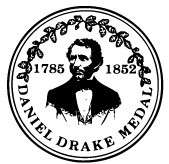
Cardiology Experts Win 2009 Drake Medals
A basic scientist and a clinician-researcherboth focused on advancing the field of cardiologyare the 2009 Daniel Drake medalists.
The UC College of Medicine honored Jeffrey Robbins, PhD, and Paul Stein, MD, May 24, 2009, at a dinner and awards celebration named in honor of the colleges founder.
Considered to be the colleges highest honor, the Daniel Drake Medal is given annually to current faculty or alumni who have made outstanding or unique contributions to medical education, scholarship or research.
Drs. Robbins and Stein embody the College of Medicines mission to improve health through best clinical practices and innovative research, said David Stern, MD, College of Medicine dean and vice president for health affairs. The College of Medicine has identified cardiovascular disease as a key focus moving forward and this years Daniel Drake medalists set strong examples of the kind of discovery we embrace and care we strive to provide.
Daniel Drake (1785-1852) founded the UC College of Medicine in 1819. It is considered to be the oldest medical college west of the Allegheny Mountains.
Jeffrey Robbins, PhD
Jeffrey Robbins serves as professor of pediatrics at UC and chief of the molecular cardiovascular biology division at Cincinnati Childrens Hospital Medical Center. He is also the associate chair for research cores and the executive co-director of the Heart Institute at Cincinnati Childrens Hospital Medical Center.
Robbins received his PhD in genetics and development in 1976 from the University of Connecticut and rose through the academic ranks, becoming professor of pharmacology and cell biophysics at the UC College of Medicine in 1987. He has won a number of teaching and research awards, including the Golden Apple, awarded by the medical students for excellence in teaching, the Kaplan Award for innovative research, the National Research Achievement Award from the American Heart Association and the Presidential Award from the International Society for Heart Research. He was an Established Investigator of the American Heart Association as well.
In 1993, Robbins moved to Cincinnati Childrens Hospital Medical Center to start the new division of molecular cardiovascular biology, and in July 2009, formed the Cincinnati Childrens Heart Institute.
Robbins early work led to the development of tools that are currently used worldwide to affect the protein complement of the heart. His work has focused on understanding the behavior of both the normal contractile proteins and the mutations that cause cardiovascular disease. He has served on and chaired numerous national research review committees for the National Institutes of Health and the American Heart Association. He currently serves on 12 editorial boards, is associate editor for the leading cardiovascular journal and is the Cardiovascular Section editor for the Annual Review of Physiology.
Paul Stein, MD
Paul Stein is director of research education at St. Joseph Mercy Oakland Hospital in Pontiac, Mich., and professor, full-time affiliate, in the department of medicine at Wayne State University School of Medicine in Detroit. He also serves as adjunct professor of medical physics at Oakland University in Rochester, Mich.
A native Cincinnatian, Stein attended Walnut Hills High School and graduated in 1955 from the University of Cincinnati with a bachelor of science with honors in physics, and from the UC College of Medicine in 1959. He completed fellowship training at the University of Cincinnati, Mount Sinai Hospital, New York, and at Bent Brigham Hospital (now Brigham and Womens Hospital) in Boston. Stein was director of the cardiac catheterization laboratory at the University of Oklahoma from 1969 to 1973, was appointed professor of research medicine in 1973 and was director of bioengineering from 1973 to 1976. He then moved to Henry Ford Hospital in Detroit where, for 19 years, he was director of cardiovascular research. He has been at St. Joseph Mercy Oakland Hospital since 2000.
Determination of the mechanism of heart sounds and applying this information to the bedside examination was one of Steins areas of research. Through bench-top investigations with high-speed cinematography, investigations in animals, and then patients, he identified the primary source of vibrations productive of heart sounds. He showed that heart sounds are initiated by vibrations of the cardiac valves after closure.
To further study vibrations of the heart valves and other structures, Stein developed a method for taking X-ray movies at 2,000 frames per second. For his contributions to engineering, he was made a Fellow in the American Society of Mechanical Engineering.Related Stories
Local media cover $13.5 million gift benefiting ALS research and...
May 2, 2024
A historic $13.5 million gift from the estate of Hugh H. Hoffman will revolutionize amyotrophic lateral sclerosis (ALS) at the ALS Multidisciplinary Clinic at the University of Cincinnati Gardner Neuroscience Institute.
New York Magazine: Does eating chocolate actually trigger...
May 2, 2024
The University of Cincinnati's Vincent Martin was featured in a New York Magazine/The Cut article discussing the lack of solid evidence that chocolate is a migraine trigger.
Yahoo News: Doctors see rising rates of colon cancer in younger...
May 1, 2024
Yahoo News featured comments from the University of Cincinnati's Rekha Chaudhary in a story about rising rates of diagnoses and deaths from colorectal cancers among young people.
